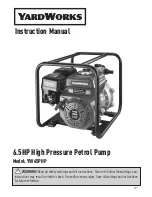
6.3 Check the lubricant level
Check the lubricant level
1. Regularly check the lubricant level while the vacuum pump is running and at operating tempera-
ture.
2. Make sure that the level is in the area at the center of the sight glass.
3. Check operating fluid fill level daily during continuous operation, and every time vacuum pump is
switched on.
6.4 Adjusting sealing gas amount
WARNING
Risk of injury from reactive, potentially explosive or other hazardous gas/air mixtures
Uncontrolled gas inlet of air or gases containing oxygen provides ideal conditions for the formation of
unexpected explosive gas/air mixtures in the vacuum system. This results in severe injuries.
► Use only inert gases for supplying the sealing gas supply in order to avoid a potential ignition.
NOTICE
Property damage from impermissibly high sealing gas pressure
Excessive sealing gas pressure leads to damage to the seals after switching on the vacuum pump.
► Make sure that the sealing gas pressure inside the pump does not exceed 1200 hPa.
► Stop the sealing gas supply immediately after switching off the vacuum pump.
The set quantity of sealing gas influences effective pumping speed and achievable ultimate pressure.
Depending on the operating pressure, the empirical value for the supplied sealing gas amount is be-
tween 1 % (for a high operating pressure) and 8 % (for a lower operating pressure) of the effective suc-
tion capacity.
Required consumables
● Inert gas, e.g. nitrogen (N
2
)
Procedure
1. Open the sealing gas supply on the gas cylinder.
2. Set a max. pressure of 2500 hPa on the pressure reducer.
3. Set the desired quantity of sealing gas on the dosing valve of the flow meter.
Formula for calculating the sealing gas flow:
Q
S
= (S
th
× p × A
S
)/p
0
● Q
S
= Sealing gas flow under standard conditions [Nm
3
/h]
● p = Intake pressure [hPa]
● p
0
= Ambient pressure under standard conditions [hPa]
● ∆p = Differential pressure max. [hPa]
● p
V
= Fore-vacuum pressure [hPa]
● A
S
= Sealing gas content at the operating gas flow (0.01 ≤ A
S
≤ 0.08)
● S
th
= Rated volume flow rate of the roots pump [m
3
/h]
Example for Okta 500 G with 50 hPa intake pressure and 8 % sealing gas content
Q
S
= (490 × 50 × 0.08)/1013
Q
S
= 1.93 Nm
3
/h
At discharge pressures > 100 mbar:
Q
S
= (S
th
× (p
V
– ∆p) × A
S
)/p
0
Operation
29/54
















































